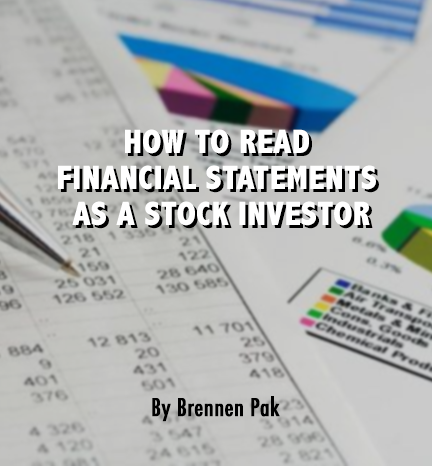Read Financial Statements as a Stock Investor

Properties
| Course Instructor | Brennen Pak |
| Total Course Duration | 3.5 Hours |
| Total Videos | 20 Videos |
| Level | Beginner |
| Language | English |
| Access Type | Full Lifetime Access |
Financial statements of a company are financial documents compiled by the company for its existing shareholders to update them of the company’s recent year state of financial affairs as well as its financial performance. To enable shareholders to have a better idea of the financial performance, it is usual that the financial figures for the preceding 1-2 years are included in the financial statement as well.
In a nutshell, financial statements are a compiled version of a company’s historical financial record. It is also the first go-to document for potential investors to use them to assess if the company is worth investing into going forward.
The figures in financial statements are generally used as a basis for potential investors to decide whether to invest in the company. So, for existing shareholders or potential investors alike, understanding the financial statements is the most basic but most important foundation block to have a good grasp of a company’s financial well-being. While it is not exactly difficult to read and completely understand financial statements to some investors, it can still present some challenges for others. “Read Financial Statements as a stock investor” is specifically designed to enable this group of learners to better understand and to be able to read financial statements effectively.
The objective of the course is to enable students to apply the skill-set learnt from the course to assess other companies’ financial affairs and their performances as well.
As the Chinese guru Lao Tze mentioned more than 2,500 years ago, “Journey of a thousand miles begins with the first step”, this is exactly what the course aims to do. The course takes you right from the first step of the financial learning journey by helping you learn how to read financial statements effectively without bombarding you with too many technical jargons and draggy explanations.
The course aims to bring up your skill level to be able to size up a company’s financial well-being within about 45 mins. This will help you, in a quick time, decide whether you should continue to invest in the company or to forego it altogether.
Once you attained the skills to be able to read the financial statements taught in this course, you should be able to apply the skill-set in assessing other companies as well. It is the most basic life-skill which all investors should be equipped with at the beginning of their investing journey.
To date, “Read Financial Statements as a Stock Investor” has been the “highest rated” course for the past 4 months in its investment category on another online platform. The course has attracted students from United States, Europe, South America, Africa and Asia.
*this is the English version. For the Chinese version, kindly purchase it here.
About The Instructor

Brennen Pak is a veteran stock educator and investor who had retired at the age of 46 after attaining financial freedom. To date, he owns several stocks with several multi-baggers including two stocks that had been taken private, earning him a 6-figure sum each. Sitting on a 7-figure unrealised profit portfolio with consistent dividends, he is able to fund all his family’s past as well as present expenses all through the passive income derived from the portfolio, with extras to continue building his stock portfolio.
The interesting thing is that all this happens in the new millennium after his huge fall during the Asian financial crisis in 1997/1998. By the Asian financial crisis, he had already been investing for almost 10 years. Magically, in the next 10 years into the new millennium, he attained financial freedom after the global financial crisis. In total, he spent only 22 years in corporate life. Perhaps, you may think that he had a high paying job during his corporate stint to be able to invest aggressively? No, he was just an ordinary guy with a relatively standard remunerations just like any of his peers.
To be exact, his gross aggregate income as an employee was at most about one million dollars for the whole 22-year period even before deducting for CPF and income taxes. You may also think that his wife helped in the family expenses? No, his wife left her full-time job to be a housewife even earlier, two years before him after the birth of their child. You may think that he had sold a property, or inherited a business or inherited a fortune from a relative? No, he does not have any of those. He had never sold any property or a business. He is still staying in his matrimonial home. In fact, he has been pretty on his own at a very young age. He had to give tuition and to rely on his savings during national service to pay for his university fees. Indeed, if you meet him on the street, he may not come across to you as one who had attained financial freedom living on his own terms.
All these things came about was probably because he did one thing correctly - he started investing very early. In fact, he started investing right at the time when he earned his first dollar immediately after he graduated. But stock investing has not been plain sailing for him. He had a fair share of losses, especially in the years up to the Asian financial crisis in 1997/1998. In the first 10-years of stock investment, he was learning the ropes of investing mainly by struggling on his own. There were no social media nor discussing forums on stocks to help him frog-leap his way to financial freedom at that time. Luckily, the rising stock market in the early 90s helped. While there were some stock losses, his stock portfolio was still able to ‘sing along’ due to the market rise during the period. There is no proper investing strategy, and averaging down was simply the theme of the day. All these came to a grinding halt when the Asian financial crisis struck.
The STI tanked more than 60% to 805 at its lowest in September 1998. Needless to say, he paid a huge price for it. The Asian financial crisis had uncovered the fact that many people were doing well due to the market buoyancy and not through one’s own due diligence. In the next 10 years to the global financial crisis, he began to carry out his own due diligence in finding the stocks to re-build his portfolio. By the end of the global financial crisis, he had attained his financial freedom and left the corporate life. Today, he is managing his own stocks portfolio.
Occasionally, he trains and give talks, both online and offline.
Here is the good news. He is now sharing his knowledge with you through online courses. The courses help you equip with the necessary financial knowledge and short-cut your way without having to pay dearly for unnecessary costly mistakes. Starting early and the ability to avoid making major mistakes in your investing journey are the essential ingredients to be a true successful investor.
*this is the English version. For the Chinese version, kindly purchase it here.

